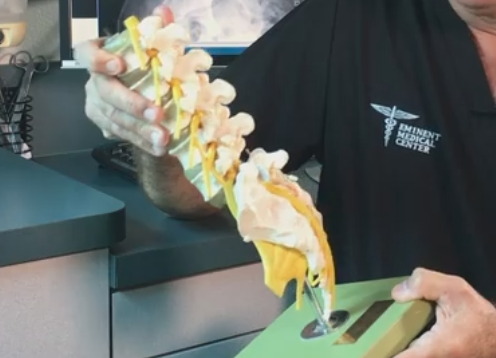Lumbar fusion is an operation that repairs degeneration of the lower part of the spine, or the lumbar back. During the operation, the surgeon connects at least two of the vertebrae in your spine so that they fuse over time into one bone. This makes the lower back stable and eases pain when you move since the nerves, ligaments and muscles in the area are also stabilized.
Are You a Good Candidate for Lumbar Fusion?
You may be a good candidate for the operation if you’ve tried more conservative treatments, and they simply have not worked to ease your pain. Your pain may be the result of an injury such as a herniated disc, a disease such as osteoarthritis or just the normal aging process.
Before the Operation
You’ll have the operation at our Richardson facility, but first you’ll have a consultation with Dr. Courtney to decide which type of surgery is best for you. There are different techniques and approaches.
In the anterior approach, the surgeon approaches the spine by making an incision in the lower part of your abdomen. In the posterior approach, the surgeon will make an incision down the middle of your back, right over the bones that will be fused.
You can also opt for an open surgery, where there is a single incision, or a minimally invasive surgery. What you and Dr. Courtney decide will depend on multiple factors that will all be discussed at your appointment.
During the Operation
The operation will need a bone graft to help your vertebrae fuse together. The extra bone can be collected from your own body. Because it is your own bone, there’s no chance of it being rejected. You can also have a bone graft from a cadaver. This is called an allograft. There are also synthetic materials that mimic bone or stimulate fusion of the vertebrae.
When the bone graft is installed, your vertebrae will need to be immobilized to help them fuse together. The surgeon will do this with screws, rods or plates. This is called internal fixation. You’ll also be given a brace.
Recovery
After the surgery you will spend two or three nights at the hospital. The doctor will have prescribed pain killing medications that you can take to manage your discomfort and muscle relaxers to alleviate muscle spasms. These can be opioids, NSAIDs and other type so pain relievers. You should not need to take these pain relievers for more than a few days after you go home. If the pain hasn’t eased up by then, get in touch with Dr. Courtney.
You will also have the help of a physical therapist who will teach you how to move to safety. Your activity level will increase over the months as the bones fuse together.
Call 972-499-5457 to schedule a neck or back consultation with one of the best orthopedic spine surgeons, Dr Courtney.
Make an Appointment today!

